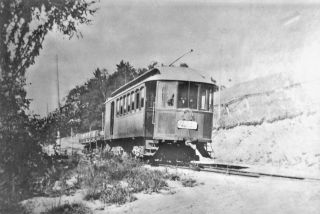Press release for the book "Lost Railroads of the Kaydeross Valley: The Electric Trolley Line of Ballston Spa, New York" Published by the Ballston Journal As part of Ballston Spa’s bicentennial celebration, Rock City Falls resident Timothy Starr has published a book about the trolley line that served Ballston Spa and other local villages in the early 1900s. Lost Railroads of the Kaydeross Valley, The Electric Trolley Line of Ballston Spa, New York relates the history of the railroad under its three corporate names, and also includes chapters concerning the history of the area as it relates to the railroad. Ballston Spa and the rest of the Town of Milton was at one time a thriving industrial basin, with over two dozen large paper mills and other businesses situated to take advantage of the water power of the Kayaderosseras Creek. The output of these mills was so great that a 12-mile long railroad was built in 1896 to transport finished goods and raw materials to and from the Delaware & Hudson Railroad interchange in Ballston Spa. In addition to being one of the shortest terminal railroads in the country, the line had other distinctions. To save money, investors decided to power it with electricity, making it one of the few electric railroads in the country designed primarily as a freight railroad. Instead of using steam engines to haul freight cars up and down the line, clean-running and quiet trolley cars were used, which had the added advantage of being able to carry passengers and mail without incurring the costs of purchasing separate passenger cars. Despite its short length and relatively short history, the railroad played a crucial role in prolonging the competitiveness, and therefore the lives, of the industries it served. Thousands of residents were employed by these industries, which included one of the world’s largest paper bag operations, the country’s largest tannery, and the famous Isaiah Blood axe and scythe works. In addition to providing inexpensive transportation for these businesses, the trolley conveyed employees to work, carried mail, distributed supplies, and transported students from the country to the high school in Ballston Spa. These students affectionately called it the PP&J, short for “Push, Pull & Jerk.” Lost Railroads of the Kaydeross Valley contains detailed information on the railroad and the mills it served, including extensive financial data, original documents, officer and director listings, maps, 48 black & white photographs, 21 color photographs, a timeline, and extensive bibliography. There is even a chapter that details various locations where the remains of the railroad and several industries can be seen today. Mr. Starr is currently working on the companion book to this one, titled Lost Industries of the Kaydeross Valley. For over one hundred years, the huge industries that operated along the creek dominated daily life throughout the Town of Milton. The new book will relate their histories and reveal details that have never before been published. Prices for Lost Railroads of the Kaydeross Valley are $46.95 for the hardcover version and $34.95 for the paperback version. Due to the high costs of self-publishing a local history book such as this one, the author says that this will very likely be a limited-run printing. It is available for sale at the Brookside Museum, Saratoga County Historical Society at 6 Charlton Street, Ballston Spa.
|

